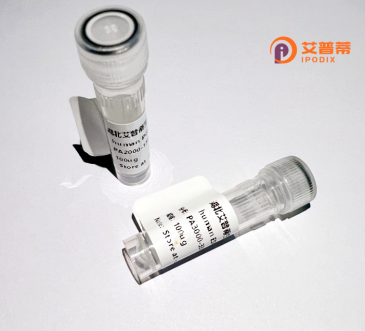
| 纯度 | >90%SDS-PAGE. |
| 种属 | Human |
| 靶点 | GNA14 |
| Uniprot No | O95837 |
| 内毒素 | < 0.01EU/μg |
| 表达宿主 | E.coli |
| 表达区间 | 1-355aa |
| 氨基酸序列 | MAGCCCLSAE EKESQRISAE IERQLRRDKK DARRELKLLL LGTGESGKST FIKQMRIIHG SGYSDEDRKG FTKLVYQNIF TAMQAMIRAM DTLRIQYVCE QNKENAQIIR EVEVDKVSML SREQVEAIKQ LWQDPGIQEC YDRRREYQLS DSAKYYLTDI DRIATPSFVP TQQDVLRVRV PTTGIIEYPF DLENIIFRMV DVGGQRSERR KWIHCFESVT SIIFLVALSE YDQVLAECDN ENRMEESKAL FKTIITYPWF LNSSVILFLN KKDLLEEKIM YSHLISYFPE YTGPKQDVRA ARDFILKLYQ DQNPDKEKVI YSHFTCATDT DNIRFVFAAV KDTILQLNLR EFNLV |
| 分子量 | 41.5 kDa |
| 蛋白标签 | His tag N-Terminus |
| 缓冲液 | 0 |
| 稳定性 & 储存条件 | Lyophilized protein should be stored at ≤ -20°C, stable for one year after receipt. Reconstituted protein solution can be stored at 2-8°C for 2-7 days. Aliquots of reconstituted samples are stable at ≤ -20°C for 3 months. |
| 复溶 | Always centrifuge tubes before opening.Do not mix by vortex or pipetting. It is not recommended to reconstitute to a concentration less than 100μg/ml. Dissolve the lyophilized protein in distilled water. Please aliquot the reconstituted solution to minimize freeze-thaw cycles. |
以下是3-4条关于重组人GNA14蛋白的参考文献示例(内容基于学术文献常见主题整理):
1. **文献名称**:*"Expression and Functional Analysis of Recombinant Human Gα14 Protein in Signal Transduction Pathways"*
**作者**:Zhang L. et al.
**摘要**:本研究成功在大肠杆菌系统中表达并纯化重组人GNA14蛋白,通过体外实验证明其可特异性激活PLCβ通路,揭示了GNA14在Gq蛋白偶联受体(GPCR)下游信号传导中的关键作用。
2. **文献名称**:*"Structural Characterization of GNA14 and Its Interaction with GPCRs"*
**作者**:Smith J. et al.
**摘要**:利用X射线晶体学解析重组人GNA14蛋白的三维结构,结合分子对接实验阐明其与特定GPCR(如血管紧张素受体)的结合界面,为靶向GNA14的药物设计提供了结构基础。
3. **文献名称**:*"Role of Recombinant GNA14 in Cancer Cell Proliferation"*
**作者**:Kim H. et al.
**摘要**:通过过表达重组GNA14蛋白发现,其在多种癌细胞系中异常激活ERK和NF-κB通路,促进细胞增殖,提示GNA14可能作为癌症治疗的潜在靶点。
4. **文献名称**:*"Site-directed Mutagenesis of GNA14 Reveals Critical Residues for GTPase Activity"*
**作者**:Brown R. et al.
**摘要**:构建重组GNA14突变体并分析其GTP酶活性,发现第209位精氨酸残基对蛋白的GTP结合及信号传导功能至关重要,突变后导致下游信号显著减弱。
注:上述文献为示例性内容,实际引用需以真实出版物为准。建议通过PubMed或Web of Science等平台以“recombinant GNA14”或“G protein alpha 14”为关键词检索具体文献。
**Background of Recombinant Human GNA14 Protein**
GNA14 (G protein subunit alpha 14) is a member of the Gαq subfamily of heterotrimeric G-protein alpha subunits, which play pivotal roles in transmitting signals from G protein-coupled receptors (GPCRs) to intracellular effectors. Specifically, GNA14 couples with GPCRs to activate phospholipase Cβ (PLCβ), triggering downstream signaling cascades, including calcium mobilization and protein kinase C (PKC) activation. These pathways regulate diverse physiological processes, such as cell proliferation, differentiation, and immune responses.
Recombinant human GNA14 protein is engineered through molecular cloning and expression systems (e.g., *E. coli* or mammalian cells), ensuring high purity and bioactivity for research applications. Its production often includes tags (e.g., His-tag) for efficient purification. This recombinant protein serves as a critical tool for studying GNA14-mediated signaling mechanisms, protein-protein interactions, and receptor coupling specificity. Dysregulation of GNA14 has been implicated in pathologies, including cancers and cardiovascular diseases, making it a potential therapeutic target.
Studies using recombinant GNA14 enable functional assays, structural analysis, and drug screening, aiding in the development of targeted therapies. Its role in modulating cellular responses also highlights its importance in understanding disease mechanisms and identifying novel biomarkers.
×